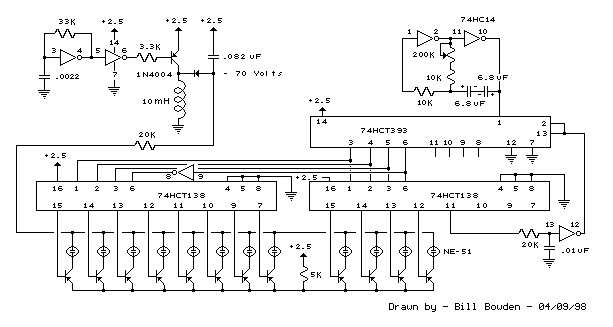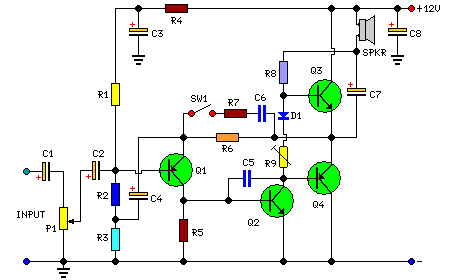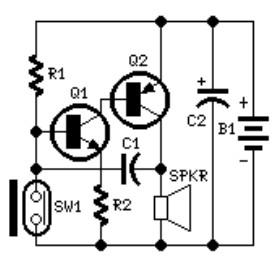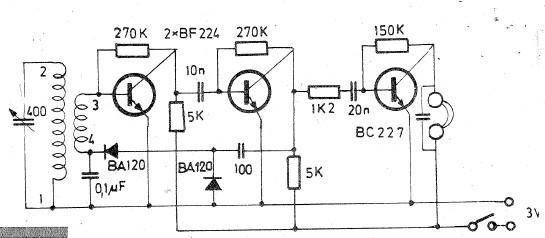
12 Neon Lamps Sequencer circuit

This circuit is similar to the LED clock using 12 neon indicator lamps instead of LEDs. It operates from 2 high capacity ni-cad cells (2.5 volts) which keep it going for a couple weeks. High voltage (70 volts) for the neon lamps is obtained from a small switching power supply using a 74HC14 Schmitt trigger squarewave oscillator, high voltage switching transistor, and 10 mH high Q inductor. Most any small PNP transistors can be used that have a C/E voltage rating of 80 or more. The inverter stage (pins 5,6) is not needed and is just an extra stage. An adjustable low frequency oscillator made from two of the inverter stages generates the clock signal for the 74HCT393 binary counter. In this circuit, the timing capacitor should be non-polarized since the capacitor will charge in both directions, so two 6.8 uF tantalum caps were used back to back which yields about 3.3 uF. The 75K resistor in series with pin 1 limits the current through the input protection diodes when the capacitor voltage exceeds the supply voltage. This resistor may not be necessary with small capacitors at low voltage but was added as a precaution. The binary counts are decoded into 1 of 12 outputs by the 74HCT138 decoders and operates the same way as in the 28 LED clock circuit. The sequence can be extended to 16 by omitting the reset circuit and tying pins 2 and 13 of the counter to ground.
This circuit design utilizes a set of 12 neon indicator lamps to create a visual clock display, similar to traditional LED clock circuits. The power supply for the entire circuit is derived from two nickel-cadmium (Ni-Cad) cells, providing a total voltage of 2.5 volts, which is sufficient to maintain operation for an extended period, typically a couple of weeks.
For the neon lamps to function, a high voltage of approximately 70 volts is necessary. This voltage is generated by a compact switching power supply that incorporates a 74HC14 Schmitt trigger configured as a square wave oscillator. The oscillator's output drives a high voltage switching transistor, which in turn energizes a 10 mH high-Q inductor to step up the voltage to the required level for the neon lamps. A variety of small PNP transistors can be employed in this role, provided they possess a collector-emitter voltage rating of at least 80 volts.
The circuit also features an adjustable low-frequency oscillator constructed from two inverter stages of the 74HC14. This oscillator generates the clock signal that drives a 74HCT393 binary counter. A critical component of this design is the timing capacitor, which must be non-polarized due to the bidirectional charging nature of the circuit. For this purpose, two 6.8 µF tantalum capacitors are arranged back-to-back, resulting in an effective capacitance of approximately 3.3 µF.
To protect the input of the binary counter, a 75K ohm resistor is placed in series with pin 1. This resistor serves to limit the current flowing through the input protection diodes, particularly when the voltage across the capacitor exceeds the supply voltage. While this resistor may be deemed unnecessary for small capacitors operating at low voltages, it is included in the design as a precautionary measure.
The binary output of the 74HCT393 counter is decoded into one of twelve outputs using a 74HCT138 decoder, facilitating the control of the neon lamps in a manner analogous to the operation of a 28 LED clock circuit. Additionally, the design allows for an extension of the counting sequence to 16 outputs. This can be achieved by omitting the reset circuit and grounding pins 2 and 13 of the counter, thus enabling the use of additional outputs if desired.This circuit is similar to the LED clock using 12 neon indicator lamps instead of LEDs. It operates from 2 high capacity ni-cad cells (2.5 volts) which keep it going for a couple weeks. High voltage (70 volts) for the neon lamps is obtained from a small switching power supply using a 74HC14 Schmitt trigger squarewave oscillator, high voltage switching transistor, and 10 mH high Q inductor. Most any small PNP transistors can be used that have a C/E voltage rating of 80 or more. The inverter stage (pins 5,6) is not needed and is just an extra stage. An adjustable low frequency oscillator made from two of the inverter stages generates the clock signal for the 74HCT393 binary counter. In this circuit, the timing capacitor should be non-polarized since the capacitor will charge in both directions, so two 6.8 uF tantalum caps were used back to back which yields about 3.3 uF.
The 75K resistor in series with pin 1 limits the current through the input protection diodes when the capacitor voltage exceeds the supply voltage. This resistor may not be necessary with small capacitors at low voltage but was added as a precaution.
The binary counts are decoded into 1 of 12 outputs by the 74HCT138 decoders and operates the same way as in the 28 LED clock circuit. The sequence can be extended to 16 by omitting the reset circuit and tying pins 2 and 13 of the counter to ground.
🔗 External reference
This circuit design utilizes a set of 12 neon indicator lamps to create a visual clock display, similar to traditional LED clock circuits. The power supply for the entire circuit is derived from two nickel-cadmium (Ni-Cad) cells, providing a total voltage of 2.5 volts, which is sufficient to maintain operation for an extended period, typically a couple of weeks.
For the neon lamps to function, a high voltage of approximately 70 volts is necessary. This voltage is generated by a compact switching power supply that incorporates a 74HC14 Schmitt trigger configured as a square wave oscillator. The oscillator's output drives a high voltage switching transistor, which in turn energizes a 10 mH high-Q inductor to step up the voltage to the required level for the neon lamps. A variety of small PNP transistors can be employed in this role, provided they possess a collector-emitter voltage rating of at least 80 volts.
The circuit also features an adjustable low-frequency oscillator constructed from two inverter stages of the 74HC14. This oscillator generates the clock signal that drives a 74HCT393 binary counter. A critical component of this design is the timing capacitor, which must be non-polarized due to the bidirectional charging nature of the circuit. For this purpose, two 6.8 µF tantalum capacitors are arranged back-to-back, resulting in an effective capacitance of approximately 3.3 µF.
To protect the input of the binary counter, a 75K ohm resistor is placed in series with pin 1. This resistor serves to limit the current flowing through the input protection diodes, particularly when the voltage across the capacitor exceeds the supply voltage. While this resistor may be deemed unnecessary for small capacitors operating at low voltages, it is included in the design as a precautionary measure.
The binary output of the 74HCT393 counter is decoded into one of twelve outputs using a 74HCT138 decoder, facilitating the control of the neon lamps in a manner analogous to the operation of a 28 LED clock circuit. Additionally, the design allows for an extension of the counting sequence to 16 outputs. This can be achieved by omitting the reset circuit and grounding pins 2 and 13 of the counter, thus enabling the use of additional outputs if desired.This circuit is similar to the LED clock using 12 neon indicator lamps instead of LEDs. It operates from 2 high capacity ni-cad cells (2.5 volts) which keep it going for a couple weeks. High voltage (70 volts) for the neon lamps is obtained from a small switching power supply using a 74HC14 Schmitt trigger squarewave oscillator, high voltage switching transistor, and 10 mH high Q inductor. Most any small PNP transistors can be used that have a C/E voltage rating of 80 or more. The inverter stage (pins 5,6) is not needed and is just an extra stage. An adjustable low frequency oscillator made from two of the inverter stages generates the clock signal for the 74HCT393 binary counter. In this circuit, the timing capacitor should be non-polarized since the capacitor will charge in both directions, so two 6.8 uF tantalum caps were used back to back which yields about 3.3 uF.
The 75K resistor in series with pin 1 limits the current through the input protection diodes when the capacitor voltage exceeds the supply voltage. This resistor may not be necessary with small capacitors at low voltage but was added as a precaution.
The binary counts are decoded into 1 of 12 outputs by the 74HCT138 decoders and operates the same way as in the 28 LED clock circuit. The sequence can be extended to 16 by omitting the reset circuit and tying pins 2 and 13 of the counter to ground.
🔗 External reference





